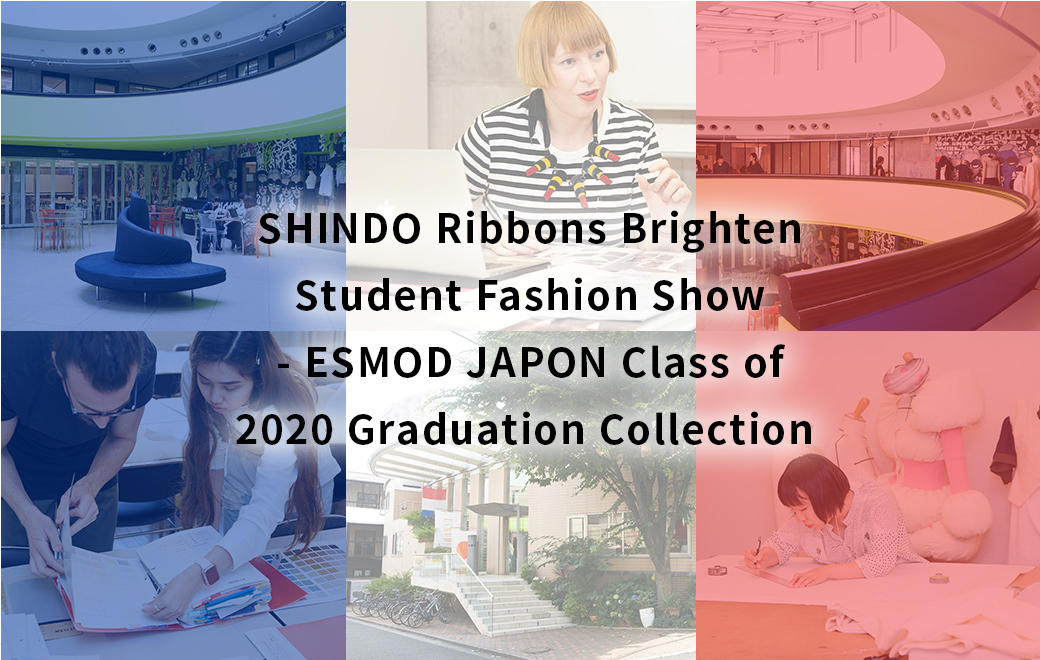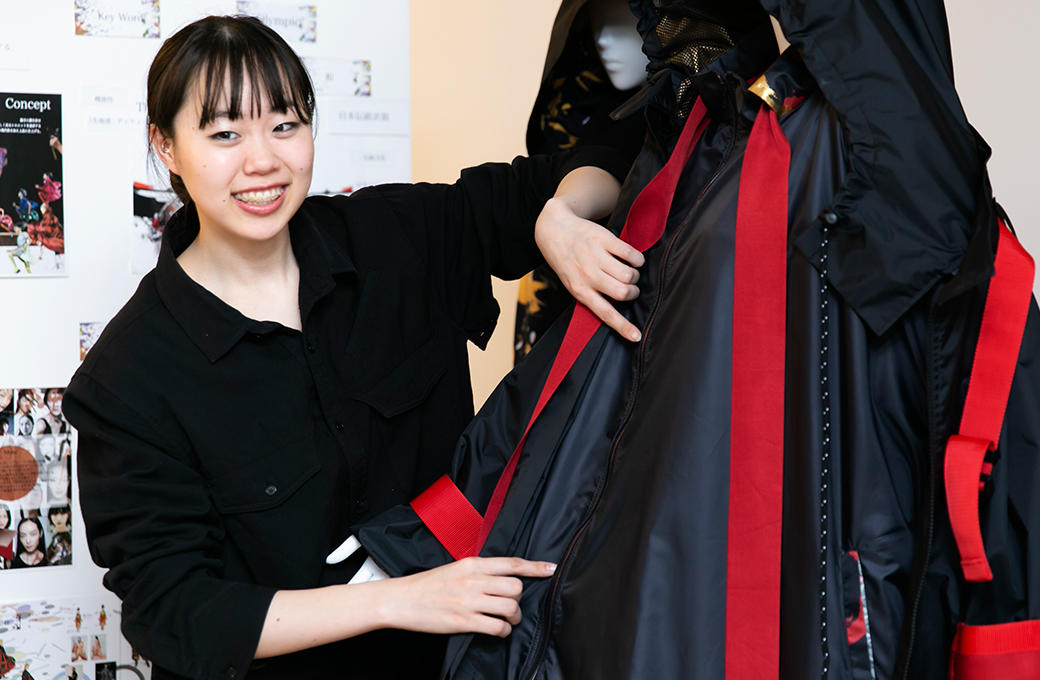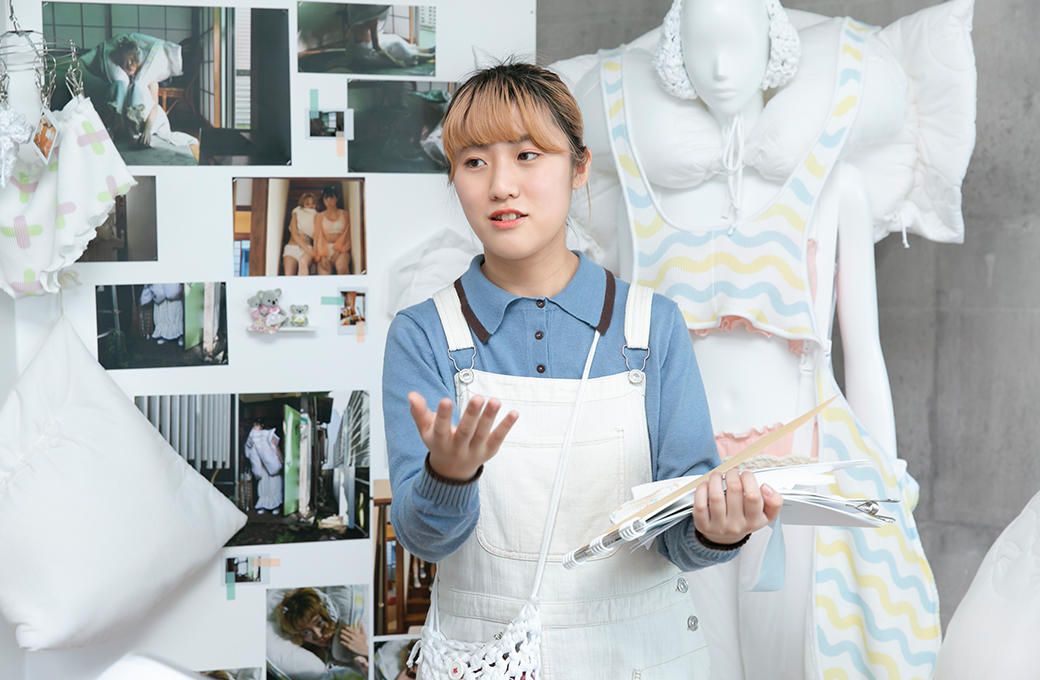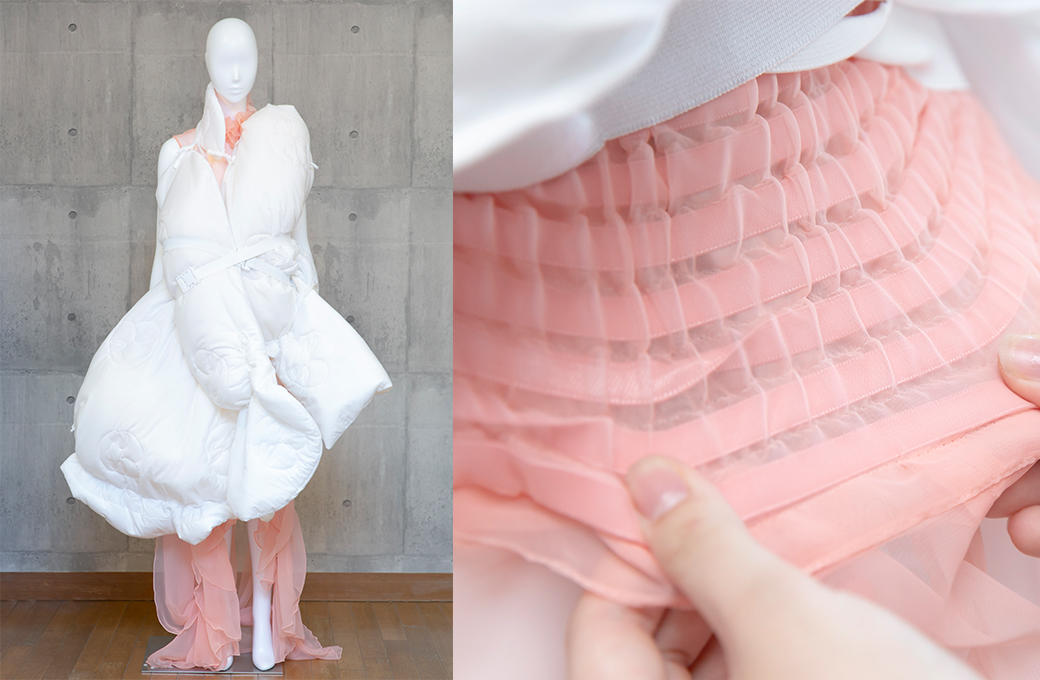EventApr 28 2020

The fashion school ESMOD originated in France, and now has a network of schools in 13 countries around the world. In February, a graduation collection fashion show event was held at ESMOD's Tokyo school. Each of the students poured their heart, body and soul into creating their designs, and every piece was fantastic and well worth seeing. Although unfortunately we cannot introduce all of them here, we have highlighted the work of four students and asked them about their designs. Please enjoy reading about them, along with pictures of the collection from the day of the show itself.

▲From left: Mayu Furuta, Rina Hirao, Anna Motono and Ayane Ishii

The theme for my designs was "Hand-Me-Downs." Hand-me-down garments often pass to several owners, and are worn as treasured items. At the same time, large volumes of clothing are displayed on racks in stores, and items that stop selling are discarded as surplus inventory. I feel that the awareness of treasuring clothes and wearing them for a long time is disappearing, such as in people buying cheap items of clothing and only wearing them for one season (before throwing them out). From spring, I will become a designer myself, and so I chose this theme with the hope of wanting to make clothes that people will wear for a long time.
The concept of my designs is that of a small girl wearing large-sized adult shirts as hand-me-downs. I paid particular attention to coming up with ways to express how this young girl, although only a child, finds inventive ways to somehow make these large shirts fit her own body size. The many red ribbons express how the girl has used strings collected from around the house to roll and tie up the shirt, which is so long that it touches the floor. For that reason, I chose to deliberately avoid uniformity by not using the same type of ribbon throughout the design, and instead used five different types. Because I incorporated the color red as an iconic symbol for the young girl, I was also particular about the specific shade of red I used. I couldn't find a red shirt that exactly matched the image I had in mind, so I dyed one myself.
I used SHINDO's S.I.C. for all of the red ribbons, which you could say are an iconic feature of my designs. The showroom had many types of ribbon even just in red, and there was also an extensive range of color tones, so I was able to discover red ribbons that matched my image perfectly! I created four designs in total, featuring six different types of red ribbon.


The theme for my designs was "The Olympics (Japan x Sports)." Initially, I thought that I would create sportswear designs, but I also had the feeling of wanting to add something else, a different kind of essence. The Olympic Games will be held in Japan this year, and so I felt that there was really no other option but to use Japan (specifically Wa, or traditional Japanese style) and the Olympics as the theme for my designs.
The point that I paid particular attention to was ensuring a 50/50 ratio of sports and Wa elements in my designs. The individual themes for my four pieces were (from left) Ninja, Kimono, Samurai and Kabuki; and I studied quite a lot about traditional Japanese costumes in creating them. For my own particular favorite, Kimono, I incorporated layers inspired by the traditional junihitoe style of kimono (literally "twelve layers"), as well as kimono-style sleeves and obi (sashes), but also worked hard to ensure that the Wa aesthetic was not too heavily emphasized. Because it is sportswear, I was also particular about functional aspects, such as in ensuring that the garments make it easy to move, and also using water repellent materials.
For my Kimono piece, I used grosgrain ribbon for around the collar, sleeve openings and waist. These ribbons are not simply for decoration, but also have a functional use, as they can be used to adjust the size and silhouette of the garment by tightening the sleeves and waist. Apart from the grosgrain ribbon, I also used S.I.C. materials for the piping (to accentuate the seams along the fasteners and when switching between different materials) and as the draw cord for the hood.
For my Ninja design I used a 7.5cm elastic belt for the waist section. When I found it in the SHINDO showroom, I couldn't help but feel thrilled! I was really thankful because there is really nowhere else where I would be able to get hold of such a thick elastic belt.


The theme for my designs was "Garments that Give Us a Splash Color, and a Little Stimulation." I've had an interest in neon art for some time, and the work of an artist who I'm currently interested in inspired me to choose this theme. His work is very beautiful in terms of his use of space and perspective, and how he interlaces straight lines with curves. Another reason is that the way in which his lines are interwoven is not straight but warped, and this also overlapped with the kind of clothes I wanted to create.
I paid particular attention to the use of lines, and how they were interwoven, and also to the materials I used. Although my concept involved neon, I wanted to avoid simply using LED lights, and so I chose to use reflective string and clear string with aurora coloring inside it. As a result, when a light is shone on the garment in the dark it actually emits brighter light than LEDs would do, because of the reflective material.
As well as the reflective material I used in all parts of the woven fabric, about 80% of the design was made using SHINDO's materials, including the string with aurora coloring inside it, while the remaining 20% was made using original strings that I made myself. By interweaving several different kinds of strings and tapes and passing them through a mesh fabric, I made a single piece of cloth, and used it to create pants and dresses.


The theme for my designs was "Living in a Dream." Partly because I am interested in childish clothing, and also partly because I like child-like clothing myself, I decided to make garments that enable the wearer to enjoy being a kid again. When it came to translating this concept into a collection, the keyword that came to mind was "dream." Based on that keyword, I envisaged a koala and a girl appearing together in a dream.
I paid particular attention to how I could express the world of "dreams" in my designs, and how much I could convey my own unique personality through making things by hand. I depicted a scene with a child who doesn't want to get up in the morning, buried in their futon. I created a sense of volume with the quilt and gave it my own unique touch by adding a koala motif to the quilting, all by hand. Another key point is that I purposely removed the sense of realism by making the koala a silhouette.
I wanted to make it so that the garments could be put on and taken off using elastic, so I used S.I.C. stretch tape for the back part of the garments. This stretch tape not only stretches well but also has an interesting texture. The front side is like satin, but the reverse side feels soft and fluffy. I liked that, so I deliberately used it back to front, with the fluffy side facing out.


The graduation collection fashion show event was held on Thursday, February 6, 2020, at The Garden Hall, Ebisu, Tokyo. The theme for the show was "promesse" and "prémice": how birth is the first step (prémice) for creation, and the root of all events or undertakings (promesse) that will take place in the future. The concept for the show was "sho" (a Japanese word that carries the meaning of "birth"). Apparently the concept was chosen by the students themselves, with a double meaning expressing the moment of their "birth" as a new generation of creators, and also the fashion "show" itself, which represents the culmination of three years of study.
The show was a large-scale affair, with around 800 visitors coming to watch, and 175 pieces (looks) being presented. Many spectators voiced their approval, saying that the quality of work was everything they would expect from ESMOD.
The results of prizes announced were:
Best Design Award : Mayu Furuta
Special Award : Rina Hirao
Okayama Denim Award : Mayu Furuta
Ms. Furuta amazingly won two awards! Comments from the four students after the show were as follows.
"Although it was hard work creating this one collection over a long period of time, the feeling of accomplishment when it was finished was amazing." (Furuta)
"(Creating the collection) was a process of repetitively stumbling, crying, and picking myself up again. But I was given the opportunity to face up to myself, and finally I was able to create the designs the way I wanted to." (Hirao)
"At the end we had the opportunity to hold such a spectacular event, and it was a great experience. I think the fact that I was able to complete my designs without giving up and throwing in the towel--no matter how hard it got along the way--will be a good source of experience for me in the future." (Motono)
"This time really enabled me to feel a sense of achievement and appreciate how worthwhile it is working together with a team to create a better collection. "(Ishii)
One of the lecturers who saw the students through the show gave the following comment, expressing heartfelt joy at seeing them graduate in such fine style.
Our students are continually redefining, redrawing and reshaping the outline of the fashion world by pursuing novelty that goes beyond the bounds of imagination, and carrying the message of creating a fresh new wind of pioneering and experimental creation in the fashion industry. Now, with the birth of these new designers, and through their creations, a new story of avant-garde fashion--reborn free from all the shackles of convention and prophesizing the leading edge of this new era--will begin.

TOPCategory ArchiveEventSHINDO Ribbons Brighten Student Fashion Show - ESMOD JAPON Class of 2020 Graduation Collection